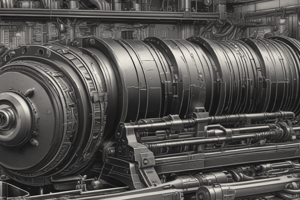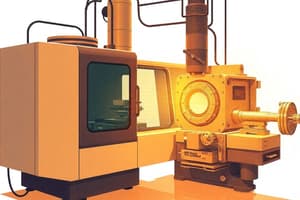Podcast
Questions and Answers
What type of milling operation produces a flat horizontal surface parallel to the axis of rotation?
What type of milling operation produces a flat horizontal surface parallel to the axis of rotation?
- Plain milling (correct)
- End milling
- Face milling
- Angular milling
Which milling operation is used to create flat vertical surfaces?
Which milling operation is used to create flat vertical surfaces?
- Face milling
- Form milling
- End milling
- Side milling (correct)
Which method is utilized to adjust the depth of cut in side milling?
Which method is utilized to adjust the depth of cut in side milling?
- Rotating the spindle
- Changing the cutter size
- Modifying the table height
- Adjusting the vertical feed screw (correct)
Which milling operation allows for producing surfaces at angles other than right angles?
Which milling operation allows for producing surfaces at angles other than right angles?
End milling can produce flat surfaces that are:
End milling can produce flat surfaces that are:
What is the primary purpose of face milling?
What is the primary purpose of face milling?
In form milling, the operation is characterized by:
In form milling, the operation is characterized by:
Which milling operation involves the cutter being positioned perpendicular to the workpiece?
Which milling operation involves the cutter being positioned perpendicular to the workpiece?
What is the primary function of the lead screw in a lathe?
What is the primary function of the lead screw in a lathe?
Which operation is used to produce a flat surface at the end of parts?
Which operation is used to produce a flat surface at the end of parts?
What is the purpose of knurling on cylindrical surfaces?
What is the purpose of knurling on cylindrical surfaces?
Which machining process enhances accuracy and surface finish by following drilling?
Which machining process enhances accuracy and surface finish by following drilling?
What type of movement does a milling machine perform with its rotary cutter?
What type of movement does a milling machine perform with its rotary cutter?
What is a significant advantage of using a milling machine over other machines?
What is a significant advantage of using a milling machine over other machines?
Which operation is primarily used for producing external or internal threads?
Which operation is primarily used for producing external or internal threads?
What type of workpieces can turning produce?
What type of workpieces can turning produce?
What is the primary function of a lathe machine?
What is the primary function of a lathe machine?
Which of the following operations can be performed on a lathe machine?
Which of the following operations can be performed on a lathe machine?
What is the purpose of the chuck in a lathe machine?
What is the purpose of the chuck in a lathe machine?
Which component of the lathe supports all the main parts?
Which component of the lathe supports all the main parts?
How is the tailstock on a lathe machine typically adjusted?
How is the tailstock on a lathe machine typically adjusted?
What material is typically used for the bed of a lathe machine?
What material is typically used for the bed of a lathe machine?
What operation does 'knurling' refer to in lathe machining?
What operation does 'knurling' refer to in lathe machining?
In lathe terminology, what does 'facing' refer to?
In lathe terminology, what does 'facing' refer to?
Flashcards
Lathe Turning
Lathe Turning
Creating straight, conical, curved, or grooved shapes on work pieces (like shafts, spindles) by reducing their diameter.
Lathe Facing
Lathe Facing
Making a flat surface on the end of a part, like preparing a part for attachment to another.
Lathe Knurling
Lathe Knurling
Creating a textured pattern on cylindrical surfaces, often for grip.
Lathe Threading
Lathe Threading
Signup and view all the flashcards
Milling
Milling
Signup and view all the flashcards
Milling Machine
Milling Machine
Signup and view all the flashcards
Cross Slide
Cross Slide
Signup and view all the flashcards
Lathe Post
Lathe Post
Signup and view all the flashcards
Lathe Machine Function
Lathe Machine Function
Signup and view all the flashcards
Lathe Machine Parts: Bed
Lathe Machine Parts: Bed
Signup and view all the flashcards
Lathe Machine Parts: Headstock
Lathe Machine Parts: Headstock
Signup and view all the flashcards
Lathe Machine Parts: Chuck
Lathe Machine Parts: Chuck
Signup and view all the flashcards
Lathe Machine Parts: Tailstock
Lathe Machine Parts: Tailstock
Signup and view all the flashcards
Lathe Machine Parts: Carriage
Lathe Machine Parts: Carriage
Signup and view all the flashcards
Lathe Operations
Lathe Operations
Signup and view all the flashcards
Lathe Applications
Lathe Applications
Signup and view all the flashcards
Plain Milling
Plain Milling
Signup and view all the flashcards
Side Milling
Side Milling
Signup and view all the flashcards
Angular Milling
Angular Milling
Signup and view all the flashcards
End Milling
End Milling
Signup and view all the flashcards
Form Milling
Form Milling
Signup and view all the flashcards
Face Milling
Face Milling
Signup and view all the flashcards
Lathe vs. Milling Machine
Lathe vs. Milling Machine
Signup and view all the flashcards
Study Notes
Experiment 5: Lathe and Milling Machines
- Aim: To study the various parts of lathes and milling machines and gain knowledge of basic operations.
- Objectives:
- Describe how lathes and milling machines operate.
- Identify various types of lathes and milling machines.
Lathe Machine
- Function: The main function of a lathe is to remove metal from a workpiece to achieve the desired shape and size. This is done by holding the workpiece securely and turning it against a cutting tool.
- Operation: The lathe machine rotates the workpiece about an axis, and cutting tools are applied to create symmetry.
- Types of Operations: The lathe can perform various operations, including cutting, sanding, knurling, drilling, deformation, facing, and turning with tools. Common tasks include making crankshafts, table legs, camshafts, candlestick holders, bowls, and other symmetrical parts. The lathe machine can also handle metalwork, metal spinning, wood turning, and glass work.
- Components (Diagrammed in page 5 and 6):
- Headstock
- Chuck
- Tool Post
- Compound Rest
- Tail Stock
- Feed Shaft
- Carriage
- Bed
- Lead Screw
- Spindle speed selector
- Headstock assembly
- Chip pan
- Apron
- Split-nut
- Clutch
- Dead center
- Tailstock quill
- Tailstock assembly
- Handwheel
- Specific Operations:
- Turning: Producing straight, conical, curved, or grooved workpieces (e.g., shafts, spindles, pins, handles).
- Facing: Creating a flat surface on the end of parts.
- Knurling: Creating regularly shaped roughness on cylindrical surfaces.
- Threading: Producing external or internal threads.
- Drilling: Creating holes.
Milling Machine
-
Function: A milling machine is a machine tool used to remove metal from a workpiece as it is fed against the rotating multi-point cutter.
-
Operation: The machine uses rotary cutters to remove material by advancing a cutter into a workpiece.
-
Components (Diagrammed in page 16):
- Overarm
- Arbor Bracket
- Arbor
- Cutting Tool
- Machine Vice
- Table
- Cross Traverse Handle
- Knee
- Vertical Traverse Handle
-
Types of Operations:
- Plain Milling: Creates a flat, horizontal surface parallel to the milling cutter's axis. It's also known as slab milling.
- Side Milling: Produces flat surfaces on the side of the workpiece. The depth of cut is controlled by the table's vertical feed screw.
- Angular Milling: Produces angular surfaces on the workpiece not at right angles to the milling machine spindle.
- End Milling: Creates flat surfaces that can be vertical, horizontal, or at an angle to the table. The machine uses end milling cutters.
- Form Milling: Creates irregular or complex contours using form cutters.
-
Milling Machine Advantages:
- Holds multiple cutters simultaneously
- High precision
- Better surface finish compared to some other machines
- Machining a variety of toolroom work
Lathe vs. Milling Machine (page 25)
- Axis: Lathe - 2 axes (x,z); Milling - 3 axes (x,y,z)
- Tool: Lathe - single-point tool; Milling - multiple-point tools (rotating cutter).
- Rotation: Lathe- workpiece rotates; Milling - Cutter rotates
- Workpiece Shape: Lathe - usually circular/cylindrical; Milling - any shape
Studying That Suits You
Use AI to generate personalized quizzes and flashcards to suit your learning preferences.




